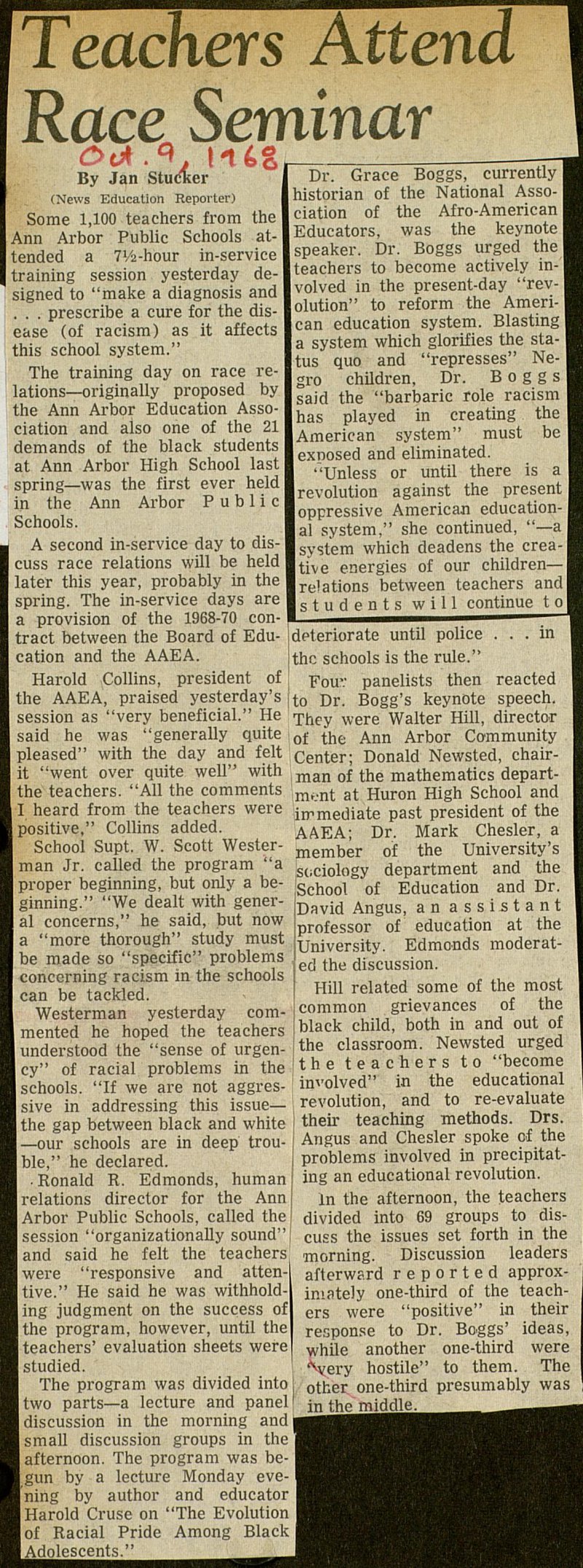Teachers Attend Race Seminar

Some 1,100 teachers from the Ann Arbor Public Schools attended a 7V2-hour in-service training session yesterday designed to "make a diagnosis and . . . prescribe a cure for the disease (of racism) as it affects this school system." The training day on race relations- originally proposed by the Ann Arbor Education Association and also one of the 21 demands of the black students at Ann Arbor High School last spring- was the first ever held in the Ann Arbor Public Schools. A second in-service day to discuss race relations will be held later this year, probably in the spring. The in-service days are a provisión of the 1968-70 contract between the Board of Education and the AAEA. Harold Collins, president of the AAEA, praised yesterday's session as "very beneficial." He said he was "generally quite pleased" with the day and feit it "went over quite well" with the teachers. "All the comments I heard from the teachers were positive," Collins added. School Supt. W. Scott Westerman Jr. called the program "a proper beginning, but only a beginning." "We dealt with general concerns," he said, but now a "more thorough" study must be made so "specific" problems conccrning racism in the schools can be tackled. Westerman yesterday commented he hoped the teachers understood the "sense of urgency" of racial problems in the schools. "If we are not aggressive in addressing this issuethe gap between black and white - our schools are in deep trouble," he declared. ■ Ronald R. Edmonds, human relations director for the Ann Arbor Public Schools, called the session "organizationally sound" and said he feit the teachers were "responsive and attentive." He said he was withholding judgment on the success of the program, however, until the teachers' evaluation sheets were studied. The program was divided into two parts- a lecture and panel discussion in the morning and small discussion groups in the afternoon. The program was begun by a lecture Monday evem'iig by author and educator Harold Cruse on "The Evolution of Racial Pride Among Black Adolescents." Dr. Grace Boggs, currently historian of the National Association of the Afro-American ïducators, was the keynote speaker. Dr. Boggs urged the eachers to become actively involved in the present-day "revolution" to reform the 1 can education system. Blasting a system which glorifies the status quo and "represses" Negro children, Dr. Boggs said the "barbarie role racism lias played in creating the American system" must be exposed and eliminated. "Unless or until there is a revolution against the present oppressive American educational system," she continued, "- a system which deadens the creative energies of our children - relations between teachers and students will continue t o deteriórate until pólice . . . in the schools is the rule." Foir: panelists then reacted to Dr. Bogg's keynote speech. They were Walter Hill, director of the Ann Arbor Community Center; Donald Newsted, chairman of the mathematics departmeñt at Hurón High School and iirmediate past president of the AAEA; Dr. Mark Chesler, a tnember of the Umversity s sociology department and the School of Education and Dr. David Angus, an assistant professor of education at the University. Edmonds moderated the discussion. Hill related some of the most common grievances of the black child, both in and out of the classroom. Newsted urged the teachers to "become involved" in the educational revolution, and to re-evaluate their teaching methods. Drs. Angus and Chesler spoke of the problems involved in precipitating an educational revolution. ín the afternoon, the teachers divided into 69 groups to discuss the issues set forth in the morning. Discussion leaders afterward reported approximately one-third of the teachers were "positive" in their response to Dr. Bo.ggs' ideas, while another one-third were ery hostile" to them. The other one-third presumably was in the middle. -
Article
Subjects
Jan Stucker
University of Michigan - School of Education
Race Relations
National Association of the Afro-American Educators
Huron High School
Education
Ann Arbor Public Schools - Teachers
Ann Arbor Education Association (AAEA)
Ann Arbor Community Center
LOH Community Centers
Old News
Ann Arbor News
Walter W. Hill
W. Scott Westerman Jr.
Ronald R. Edmonds
Mark Chesler
Harold Cruse
Harold Collins
Grace Boggs
Donald Newsted
David Angus